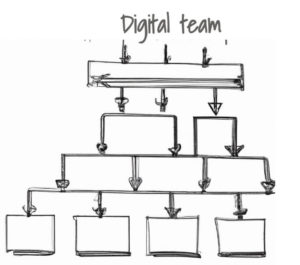Each month we go in-depth into topics discussed in one of the Master B2B Boardrooms, our monthly roundtables for B2B eCommerce executives.
What we heard in the Boardrooms:
This month’s Boardrooms were focused on two questions around organizational design:
- How do you structure teams to align with company goals, while ensuring team members and managers are set up to be successful?
- How do you incentivize individuals in a way that benefits the company as a whole?
Or, to think about it more broadly: How does the design of your organization contribute to the success or failure of your company’s initiatives?
Why that matters:
If you’re in a role where you need to hire people, you’ve likely noticed one or both of these things over the past six months:
Overall we heard lots of frustration about how their organizations were structured and little idea about how to implement changes to improve the situation. The frustrations ranged from having too many direct reports (one member said she had 40 people reporting to her) to having teams with KPI goals that are at odds with other teams’ goals.
One Boardroom member with a large online distributor talked about how they created a compensation plan that ensured alignment between teams. The management team and direct reports are on the same bonus plan, adding that they were cautious about creating a bonus KPI that conflicts with the KPIs of another department. He said he had seen bonus plans in prior jobs where one team would have a KPI that conflicted with KPIs of another team. “That builds in conflict that hits people in their wallet.”
Another Boardroom member who works for a mid-sized distributor noted that when he worked In B2C, they were bonused on one thing – profit. In his current company he said that they probably have 100 measures going into people’s bonuses, and many of them are in conflict.
As moderator Stephanie Pike said, “What gets incented, gets done,” so when KPIs are at odds you’re going to end up with a mess.

What to do about it:
Practitioners designing an organization too often fall into a trap where they make decisions based on “what feels right” or “what works elsewhere” rather than doing a deeper analysis around how to promote efficiency.
In the Boardroom meetings we discussed 5 primary considerations for assessing and building your organizational design:
- Choose a model that’ll work for you as a leader and for the culture of the company. This is often more challenging than it sounds, as many senior executives find that they are not actually empowered to design the organization how they’d like.
- Leverage data to make decisions. Given the HR platforms (like Workday) that many companies now use, companies have access to a significant amount of data to help them build better performing teams. The challenge is finding HR talent who know how to use this data to make better decisions.
- Build on the team that you have (or as one Board member said – “Go to war with the army you have, not the army you want”). Assess the talent you already have in the organization, figure out where you’re strong, and build on that (rather than panicking about what you don’t have). Fill in the critical gaps, of course, but build from strength.
- Think about “Spans and Layers”. Spans are the ratio of direct reports to managers. Layers are the number of layers an organization has from top to bottom. One Boardroom member said he has been challenged about getting promoted because his “span” was too small, since he only had one direct report. But he also managed a large number of outside agencies. As you consider spans, make sure you’re thinking about the total number of people AND agencies/consultants that someone is managing.
- Figure out who has the decision-making ability. Who is actually making the decision and who is held accountable? Oftentimes there’s an influencer who works alongside a decision-maker who has outsized impact on what gets done.



